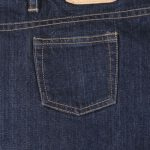Denim remains one of the world’s most popular textiles. In fact, most people wear it several times a week. But while you may have a general understanding of denim, there are probably some things you don’t know about this fabric. So, today we’re going to explore the world of denim, revealing what makes this fabric special.
Move Over Levi Strauss
Some people assume that Levi Strauss was the first person to invent denim, but this isn’t necessarily true. Before Levi Strauss began making denim jeans, there was a tailor named Jacob W. Davis. Using denim, Davis made rivet-reinforced denim pants for gold prospectors, laborers and other hard-working individuals. Reports indicate that Davis was motivated to create the denim pants after a customer has requested a special pair for chopping wood. Previously, pants on the market were too weak and often succumbed to damage. This prompted Davis to make a stronger and more durable style of pants; thus, paving the way for denim pants.
Denim is a Type of Cotton
You might be surprised to learn that denim is actually a type of cotton. The term “denim” simply refers to a strong and durable cotton with the weft passing under two or more warp threads. This construction creates diagonal ribbing that’s not found in traditional cotton. Normally, the warp thread of denim is dyed blue (light blue or indigo), whereas the weft thread is left white. This is why the interior of denim jeans is usually a different color than the exterior.
North American is The World’s Leading Consumer of Denim Jeans
While worn by millions of men and women from around the world, jeans are most commonly worn in North America. Statistics show that North America accounts for 39% of the denim jeans market. Coming in at a distant second is Western Europe at 20%, with Japan and Korea in third at 10%, and the rest of the world at 31%. To put the popularity of American jeans into perspective, the United States spends more than $15 billion on this versatile garment every year — a number that’s expected to grow even higher in the years to come.
The Word ‘Jeans’ First Appeared in the 18th Century
It’s believed that the word “jeans” was first used by a Swiss banker named Jean-Gabriel Eynard in the late 1700s. When opposing forces were invading his team, Jean-Gabriel and his brother Jacques began mass-producing jeans for local troops. The uniforms were made of heavy-duty denim and known as “bleu de Genes.” Of course, later denim trousers became known as “blue jeans” in reference to this early use. Today, blue jeans are known throughout the world as being some of the most durable and versatile denim pants on the market.
More than Just Clothes
When most people think of denim, they immediately envision jeans — and for good reason. Denim has long been the universal fabric for constructing jeans. With that said, it’s used in a wide range of other applications. In the early-to-mid 1970s, for instance, American Motors Corporation (AMC) began using denim as an interior luxury for certain vehicles, including the Jeep. The German automaker Volkswagen followed suit by producing its own denim interior dubbed the “Jeans Beetle.” Other common uses for denim include belts, handbags, furniture upholstery, lampshades and more.
You Don’t Need to Wash Denim Jeans Every Time You Wear Them
Another common misconception is that you need to wash denim jeans every time you wear them. Conventional wisdom may lead you to believe this statement is true. After all, wearing jeans makes them dirty, right? Well, in recent years several big-name fashion icons have spoken out against daily denim washing. Levi CEO Chip Burgh, for instance, says he rarely washes his jeans unless they are visibly dirty. Like all garments, washing jeans breaks down the fabric a small degree. You probably won’t notice any major changes after just a single wash, but constantly washing your jeans day after day will eventually cause them to fade and degrade. So, if you want your jeans to last and withstand the hands of time, try to get into the habit of washing them less frequently.
The World’s Oldest Pair of Jeans are Worth $80,000
According to a report by Inside Edition, the world’s oldest pair of denim jeans are expected to fetch a whopping $80,000 at auction. The 1890s jeans were owned by the Western pioneer Solomon Warner. Warner was responsible for building a settlement in Tuscon, Arizona, where he wore the jeans on a regular basis. Warner wasn’t a small man, however. He was about six foot and six inches tall, and he weighed around 300 pounds. Therefore, the size of his jeans was 44 inches in the waist and 46 inches in the inseam. Perhaps the most interesting aspect of this story, though, is the near-pristine condition in which the jeans were discovered. After Warner had passed, his jeans were safely stored in a trunk where they remained for nearly a century.
Only a Few Grams of Dye Are Used to Make Jeans
One of the defining characteristics of denim jeans is its blue color. While more than 20 thousand tons of dye are produced every year specifically for this purpose, it only takes a small amount to give jeans their distinct color. In fact, reports indicate that only a few grams of dye are needed to turn a pair of jeans blue. And if they ever fade or otherwise suffer from discoloration, you can always redye them.
Surfers Invented Acid-Washed Jeans
Did you know that Californian surfers were responsible for pioneering acid-washed jeans? In the 1960s, surfers discovered that leaving their jeans outside for long periods of time caused them to fade naturally while also creating a more “lived in” appearance. Denim manufacturers took notice of this trend and began making their own acid-washed jeans. Today, countless companies sell acid-washed jeans and other denim garments.












